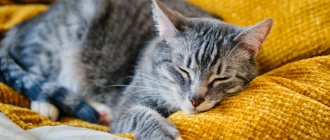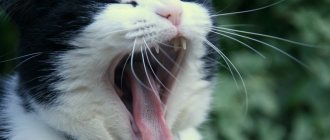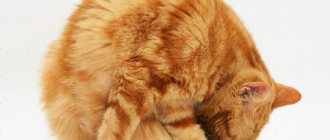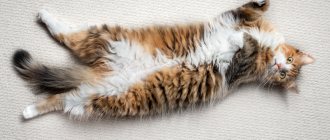White cats of any breed are aristocratic, rare, and look more spectacular than cats of other colors. That's why they are incredibly popular. Caring for a snow-white coat requires a lot of time, effort, patience and material costs from their owners. Another problem may be the pet’s complete or partial deafness.
How white cat genetics affect hearing
White color means the absence of pigment in the hair, that is, the cat has “no” color. This happens for two reasons: the enzyme for the formation of pigment does not work due to a “broken” gene, or a genetic mutation has occurred that suppresses coat pigmentation. Blue eye color is the basic color for all cats, so kittens are always blue-eyed. With age, the iris becomes colored due to incoming pigment. If the pigment is absent (not synthesized due to damage or mutation), the eyes remain blue for life.
Special cells, melanocytes, are responsible for the production of the melanin pigment. Some of their precursors turn into certain types of cells in the nervous system, including those responsible for hearing. Mutations that disrupt pigmentation reduce the number of melanocyte precursors that should become part of the hearing organs, so white color is often associated with deafness.
Diagnosis of the disease
If symptoms of deafness appear, you should show your pet to a veterinarian; only he will be able to professionally determine the presence of deafness, its level, and the cause. The following methods exist for this:
- Examination of the auricle and inner ear (using a special device - an otoscope). This allows you to determine the presence of injuries, infections, and ear parasites.
- If an infection is detected, an additional cytological examination is performed.
- The presence of genetically determined deafness can be verified using a special instrumental study that allows one to determine the auditory potential of the brain stem when the hearing organ is irritated by sound vibrations.
- If the presence of neoplasms is suspected, magnetic resonance or computed tomography is used.
How common is deafness?
As a result of natural selection, cats with white fur are practically never found in nature. This natural culling has a simple explanation: the white color is clearly visible in any landscape except snowy, and therefore reduces the chances of survival. White cats make up approximately 5% of the entire population and are preserved only thanks to the efforts of breeders who fix the trait in the breed.
Scientists became interested in the problem of deafness in white cats relatively recently - in the late 1990s. Before this, breeders had no idea that their pets were hearing impaired and spread the trait further down the line. Nowadays, such kittens are culled whenever possible - spayed or neutered.
Research has found that not all white pets are necessarily deaf. The problems have:
- 20% of white cats with non-blue eyes;
- 40% of white cats with heterochromia (deafness in one ear);
- 80% of white cats are blue-eyed.
It has also been noted that cats with long hair are more likely to suffer from deafness than their short-haired relatives.
Identifying the problem of deafness in a cat or kitten
Congenital deafness may not appear immediately. It happens that kittens are born hard of hearing, but due to a defect, less and less blood flows into the deformed ear and it completely stops hearing. This usually occurs at 3-4 weeks of life.
If only one ear is damaged, sometimes the owner may not even be aware of it. The kitten quickly adapts to life with restrictions and begins to behave in the most normal way.
A short examination at a veterinary clinic will help identify the problem. But you can also do it yourself at home. To do this, you need to do several things with the kitten and monitor his reaction:
- Take a piece of paper and tear it.
- The rustle of foil.
- Tap on a hard surface.
- Make hissing sounds.
For the reaction to be reliable, the cat does not see you. Ideally, he should take a nap with his back to you. If he hears you, he will respond to the noise. However, if there is no reaction, a more thorough examination by a veterinarian is necessary.
Sometimes signs of deafness include purring too loudly and restless sleep.
White Persian cat
How can you tell if a cat is deaf?
White cats are rarely born with hearing loss. Newborn kittens can hear, but over time, by about a month of life, signs of deafness appear. Simple tests will help determine your hearing acuity. For example, tear the paper, rustle the candy wrapper, knock next to the kitten so that he does not see the source of the sound. Lack of response indicates hearing loss. To ensure the accuracy of the diagnosis, take your pet to the veterinarian.
Deafness is by no means a reason to give up your pet. In a quiet, cozy apartment, a cat can live peacefully without hearing: the owners just need to develop a system of gestures by which the cat can understand what they want from it.
Photo source:
Symptoms of the disease
Cats adapt well to their condition at the expense of their other senses. There is a certain belief that their sensitivity is so heightened that they hear by perceiving sound vibrations in the bones of the skeleton and vibrissae. They sense movement behind them by vibrations in the air.
And yet, the onset of deafness can be determined. It is usually accompanied by the following symptoms:
- meowing too loudly;
- lack of reaction to opening the refrigerator door or to the rustling of a bag of food;
- loss of orientation, frequent looking around;
- shaking the head, rubbing the ears with a paw;
- in case of an infectious disease or sulfur plugs, an unpleasant odor may be felt;
- The old cat doesn't respond to his name.
To confirm your suspicions, you need to make some sound at some distance from the animal. A well-hearing cat will react by turning its ears. A louder sound will cause fear and a reaction from the whole body. If these signs are not present, it means that the fears have been confirmed, and the cat cannot hear at all.
Caring for a special pet
Albinos are not recommended to be kept with other pets due to the high likelihood of infection and possible harassment from cats with normal colors. Such pets require a lot of attention, so it is much calmer not to be torn between several pets.
Feeding
Due to frequent allergies and gastrointestinal problems, the best feeding option is ready-made dry food for cats with sensitive digestion. On such a diet, the animal will receive all the necessary elements without harm to health.
Mating or castration?
Serious congenital anomalies appear only in kittens that received the mutant gene from both mother and father at the same time. With a standard set of genes in at least one of the parents, all offspring are born with normal color.
It is acceptable to breed an albino cat with a regular cat, but it is better to neuter an albino cat immediately. Due to weak immunity, the pet may not survive childbirth and die.
Mackerel for weight loss: benefit or harm?
When answering this question, it is important to remember that the process of losing weight is not only about losing excess weight and burning excess calories. This is a “restart” of the body’s functioning, when the food consumed is extremely beneficial, saturates with essential substances and microelements, and, as a result, improves well-being and health. This is a “restart” of the body’s functioning, when the food consumed is extremely beneficial, saturates with essential substances and microelements, and, as a result, improves well-being and health.
This is a “restart” of the body’s functioning, when the food consumed is extremely beneficial, saturates with essential substances and microelements, and, as a result, improves well-being and health.
Everyone has heard about the benefits of seafood, due to the high content of such important vitamins for health as vitamins B, A, C, D, E, K and trace elements: phosphorus, iodine, potassium, calcium, sodium, magnesium, zinc, fluorine.
The fat content of mackerel depends on the place of catch (there are Australian, Atlantic, Far Eastern), as well as on the time - in the fall the fat content of the fish reaches 30% (the value of such fish is much higher for the body), and in the spring - about 4%.
If the protein content, for example, in Atlantic mackerel is on average 20%, and fat - 13%, then the Far Eastern mackerel has higher values (24% and 30%, respectively).
On the positive side, it is worth noting that the proteins contained in mackerel are much easier and faster absorbed by the body, unlike proteins from poultry, beef and pork.
For example, it takes almost 5 hours to digest beef, and only 2-3 hours for fish.
Being a supplier of invaluable Omega fatty acids that help prevent cardiovascular diseases, atherosclerosis, arthritis, mackerel, at the same time, can have a negative impact on metabolism if the product is of poor quality or improperly consumed.
It is important to note that only fresh or freshly frozen fish will retain all the value of the beneficial elements it contains. If the fish has been subjected to repeated freezing or temperature changes, the fats in it quickly oxidize and turn from beneficial to harmful. If the fish has been subjected to repeated freezing or temperature changes, the fats in it quickly oxidize and turn from beneficial to harmful
If the fish has been subjected to repeated freezing or temperature changes, the fats in it quickly oxidize and turn from beneficial to harmful.
So, how to properly present this product to the body, preserving valuable substances as much as possible?
You should always remember that eating mackerel is not recommended for people who suffer from liver and pancreas diseases
They should pay attention to low-fat fish varieties, such as pollock, cod
If there are no health problems, the main attention should be paid to the method of preparing mackerel dishes
Stages of a cat's life cycle
The life of any cat can be divided into several stages.
Infancy (from birth to six months)
The first six months of a baby’s life are the most significant and eventful. Ten days after birth, these are blind sucklings, whose whole world is concentrated in the warmth of the mother’s body and the nipple with milk.
By two months, kittens become quite independent, begin to feed on their own, and learn to use a litter box.
Until three or four months, the pets usually do not leave the nursery and the mother. From four to six, they resemble playful children on the cusp of adolescence.
Youth (from six months to two years)
In almost all breeds, by six months the kitten is at the beginning of puberty. Physically, he is already quite developed, almost independent.
Usually at one year the female is already able to give birth and feed kittens, although it is better if pregnancy occurs a little later, at least at 18 months. Cats mature more slowly - up to one and a half years, and in some breeds up to two or three years.
Youth (three to six years old)
Animals are considered conditionally young when they are between two and six years old. This age approximately corresponds to 20-40 years of a person. It is at the age of six that it is customary in nurseries to remove an animal from breeding.
But with good care, pets are active, healthy and capable of producing full-fledged offspring for much longer - at least up to seven to ten years.
Maturity (seven to ten years)
A cat from seven to ten years old is considered a mature individual. About the same as a person aged 40-55 years old. The animal is in the prime of life, behaves calmly and reservedly.
Older cats (eleven to fourteen years old)
From 11 to 14 years old, the cat is in old age, corresponding to human 55-70 years. If the pet does not suffer from any chronic diseases, then neither he nor the owner will have any special problems in life. Sleep time increases, whims in choosing food may appear, and there is no particular desire for outdoor games.
Old age (over fifteen years)
Pets over 15 years old can be considered 80 year olds. They are calm, unhurried, affectionate, need the attention and care of their owner, and express their devotion more clearly.
This division into age groups is very arbitrary. Many animals at 15 years old are still vigorous, playful and active. There is a known cat of the Nibelung breed that lived 36 years. She gave birth to and nursed her last kittens at 28. By the way, read about long-lived cats on our portal.










